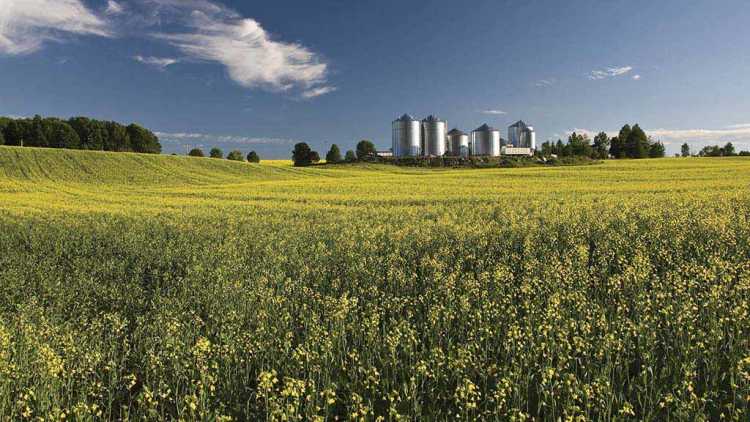3 things to consider when upgrading grain storage

When delivery space is tight at the grain elevators, producers who can deliver grain immediately, no matter what the weather is doing, have a distinct advantage over those who can’t. That’s part of why grain, oilseed and cash crop producers across Canada are growing their storage capacity in centralized, all-weather locations.
Canadian grain farmers have always liked to store their production on the farm. Since grain prices are traditionally at the lowest point of their commodity cycle during harvest, being able to deliver later in the year often means better returns.
At one time, producers liked to have grain storage on every significant parcel of land, says Lyle Muyres, Vice-President of marketing at Corr Grain Systems in Regina. Today, 20,000-acre farms aren’t uncommon on prairie farms. Farmers want to store all their grain in one location so they can more easily manage it. Many use grain bags to temporarily store grain in the field during the harvest rush and then move it to their central storage location, where it’s simpler to keep a close eye on its condition.
“A lot of the reasons farmers are improving grain storage and handling systems relate to logistical and human resource efficiency,” says Terry Betker with Backswath Management in Winnipeg. “Some farmers are running three or four combines and harvesting four or five thousand bushels an hour, so using big bins saves them a lot of time.”
1. Size and location matter
According to Muyres, the first thing to consider is where you’re going to put your new bins. Keep in mind things like elevation, proper drainage and, of course, future expansion. Just because an area might work with the trucks and handling equipment, you’re using today doesn’t mean it will work with the bigger equipment you might use in the future.
Size needs to be determined by the variety of crops you are growing today and leave some flexibility for the future.
Everyone has put grain storage in the wrong spot or in too low an area at some point, he says. “Get it up in an area where there isn’t water pooling, not only where you put your bins but also where your equipment is going to be during haul-out.”
Selecting the right sized bin can be tricky too, because it will vary from one operation to the next. He believes size needs to be determined by the variety of crops you are growing today and leave some flexibility for the future. Those who grow ten or twelve different crops choose to have more, smaller-capacity bins, while those who grow large volumes of just two or three crops tend to build big ones.
“You want to be able to set up your auger or conveyor into a bin and not have to move it for two or three days,” he says. “So, whether it’s 20-, 30- or even 50-thousand-bushel bins, pick a size that minimizes moving equipment at harvest. Then on the draw side it will allow either you or custom haulers to draw grain out very efficiently.”
2. Use the right monitoring technology
As bins on farms get bigger, though, producers are increasing the risk of catastrophic financial loss from spoilage. That’s why nearly all producers install monitoring systems, along with aeration and other systems, to manage the condition of their grain.
“It’s important you buy the right aeration and monitoring technology for your new bins,” Muyres cautions. “Don’t pick a particular system just because your neighbour has it. Pick the one that will work best with the size of your system to condition your grain.”
The technology is evolving quickly. With the newest systems, you can monitor your grain while you are away from the site. If the temperature in a bin starts to climb, the system will send an alarm to your smartphone and let you control the fans from your mobile device – even if you are out of the country.
3. Work with a grain management specialist
“If you’re thinking of building a new grain handling facility, I recommend you work with a grain management specialist,” Muyres says. “You can do it on your own, but a specialist can help walk you through the numerous options out there.
“It’s also important to make sure that whoever is installing your bins has the expertise you need,” he adds. “Lots of great product gets set up by subpar installers. It’s no different than if you build a house: the quality of the person who builds it is probably as important as the quality of the product you buy.”
When you have the right storage capacity at your farm, you stand a much better chance of being the guy at the terminal who can make just-in-time grain deliveries for the best return possible.

Learn how stock-to-use ratios can help you predict future prices and create a solid marketing plan.